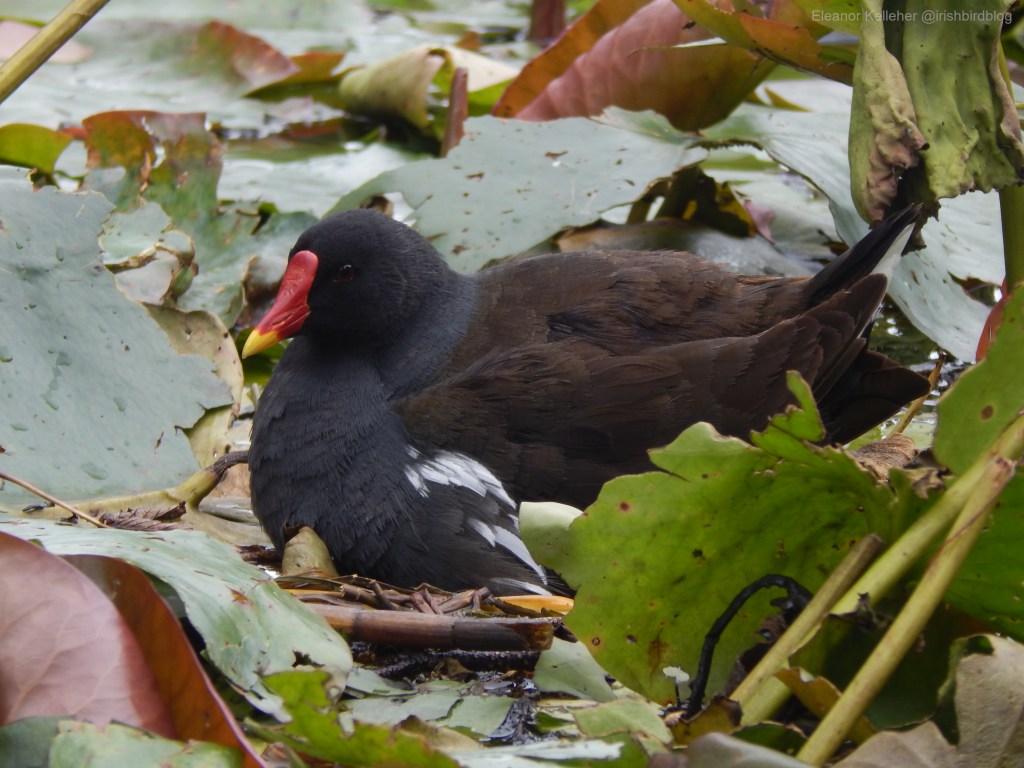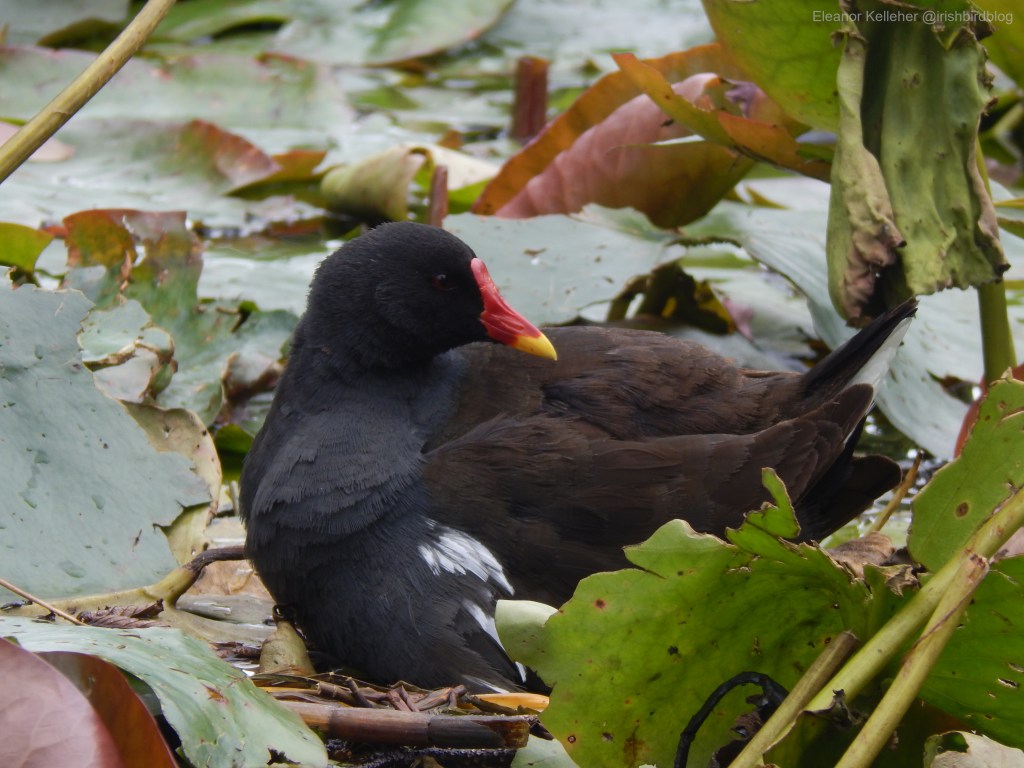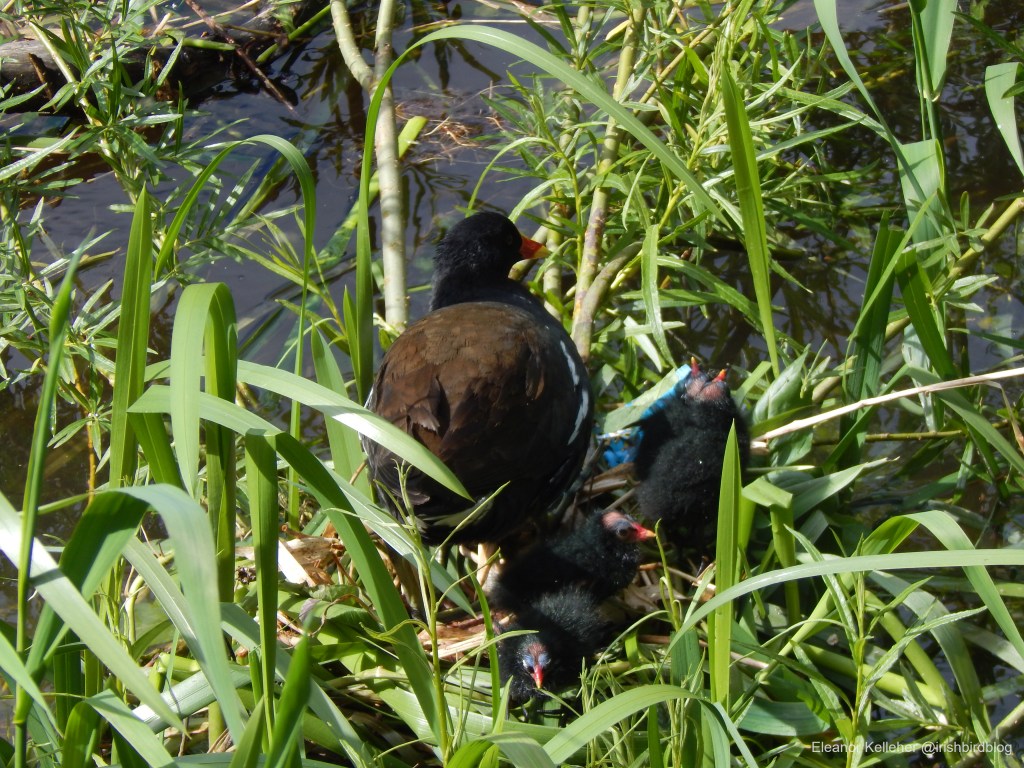We’re back with the first instalment of Bird Blog in 2024! To kick things off, we’ll be talking about a common bird that you’ll easily be able to find amongst the reeds and vegetation that line the banks of our waterways – a nice easy one to check off your birdwatching list for the year. This month’s bird is the Common Moorhen (Gallinula chloropus), known as Cearc uisce in Irish.


You’d be forgiven for mistaking the moorhen for its cousin, the common coot (who was actually the star of the first article we posted last year!), but these two birds are quite distinct. First off, the moorhen has a red frontal shield and bill with a yellow-tipped beak, while the moorhen’s is a stark white. A handy way to remember who’s who is to remember that moorhens have an R in their name for red, and coots have a hard T in their name, similar to the word “white”. Next, moorhens are a lot smaller than coots. You could probably hold a moorhen in one hand but a coot would require you to use both (note: this blog does not endorse or recommend touching wild animals). Moorhens also have plumage that’s more brownish than coots’, who sport inky black feathers. Finally, moorhens do have those disturbingly long toes, but mercifully, they aren’t as fat and flat like coot toes.
One way in which these cousins are a lot alike is that they’re both staples of Irish waterways and wetlands, particularly if those areas boast a lot of vegetation. In fact, the name moorhen comes from the old English morhen, where mor means marsh – a little marsh hen! Incidentally, both the Irish and Latin names opted to use the word “hen” to describe these birds; with the Irish name translating to “water hen” and the Latin genus name meaning “little hen”. These names have influenced the everyday nicknames these birds have earned – “marsh chicken” or, my personal favourite, “swamp chicken”.



Those aren’t the nicest nicknames but they’re unfortunately apt, especially for moorhen chicks. Adult moorhens only have unpleasant feet, moorhen chicks have unpleasant … everythings. They’re born with a big pink bald spot on the top of their head and sprouts of dull downy feathers. The chicks are precocial, meaning they’re born knowing how to be a bird, and seeing them in the water following along after a parent, they really just look like dark splotches on the water. To make matters worse, they’re born with the iconic red and yellow beak, but it dulls to grey in their teenage years (another case to add to the Everyone has an ugly teenage phase pile) before reverting to red and yellow when they mature.
To their credit, the first brood of moorhen chicks stick around to help their parents raise the second clutch of eggs; collecting food for them and guarding the nest from predators. So they have great caring personalities at least.
Moorhen nesting habits are actually quite unusual. For starters, sometimes they’ll nest in low-hanging tree branches because apparently they’re pretty decent climbers! Their nests are mounds made of grass, reeds, and twigs – standard fare for this kind of bird. What’s interesting is that they’ll actually build several nests from March onwards, then the female will choose the one she likes best to lay her eggs in when the time comes. Imagine having that much freedom when it comes to housing!



The best thing about moorhens, in my opinion, is their call. Have you ever squeezed a toy in a shop and immediately regretted the decision because it let out an explosive, high-pitched squeak, causing you to put it down quickly and speed-walk away? Well moorhens sound a lot like that. It wouldn’t surprise me if it turned out that they were the inspiration for the noise that dog toys make.
Moorhens are quite common. Pretty much anytime I’ve been near a pond or river, I’ve come across them. They’re maybe the second most common bird that I see around ponds, after mallards of course. But the most notable moorhen encounter I can think of is one where I didn’t see them at all.
It was a misty morning in Phoenix Park; the blurry shapes of trees rising out of the fog were barely visible until you came quite close to them. It was a chilly autumn day and not many people were around, if there were any at all. By the time I got to one of the ponds in the park, the atmosphere had me slightly on edge, imagining all sorts of creatures hiding in the mist. As I was standing at the edge of the water, looking out in vain, I heard the loud ridiculous trill of a moorhen somewhere nearby.
Instant vibe killer. I couldn’t help but laugh at it. If I’d been about to get lost in a horror story, that moorhen ensured that the genre of the tale switched. I still smile whenever I hear their loud squeaks off in the distance somewhere.



Ireland’s waterways are an important part of the island, and moorhens may as well be synonymous with them, as mallards and gulls are. We already have a strong resident population of moorhens but in winter (from September to April to be specific) we get an influx of migrants from mainland Europe. So there’s never been a better time to head to your nearest pond, canal, or river to check out some swamp chickens.
